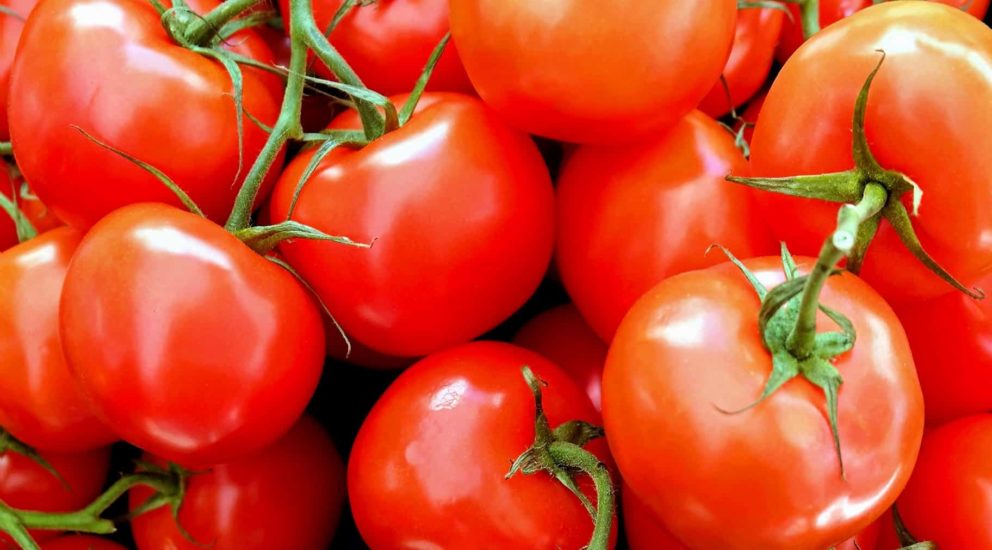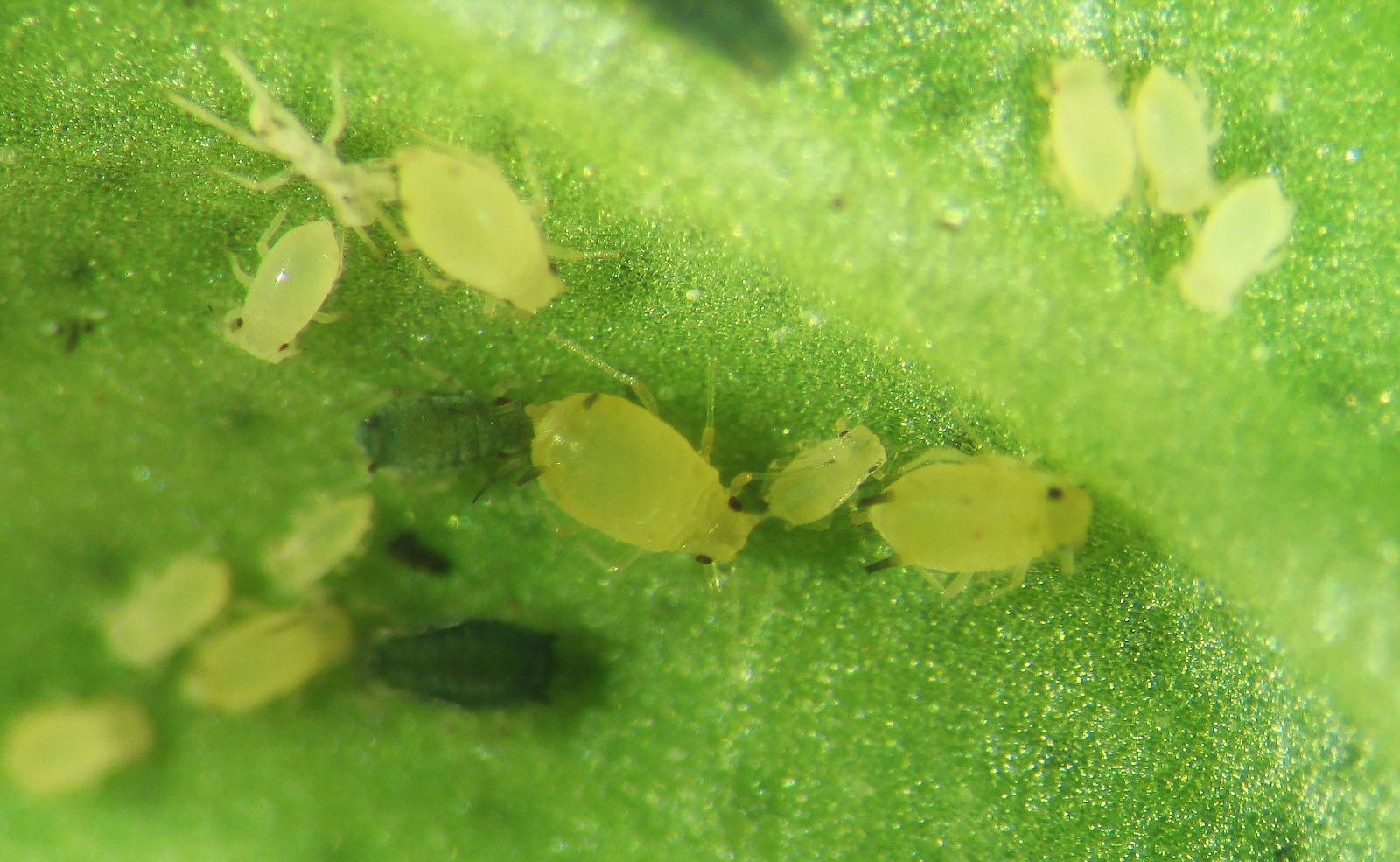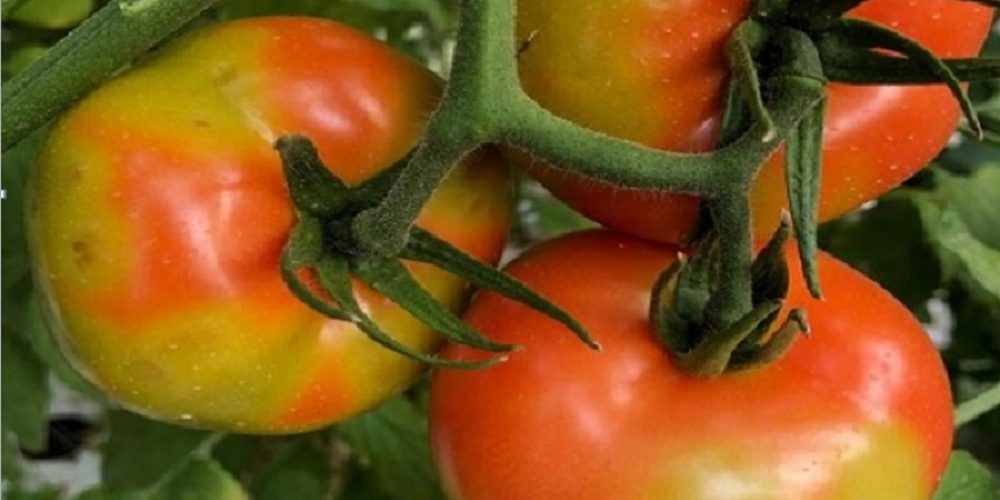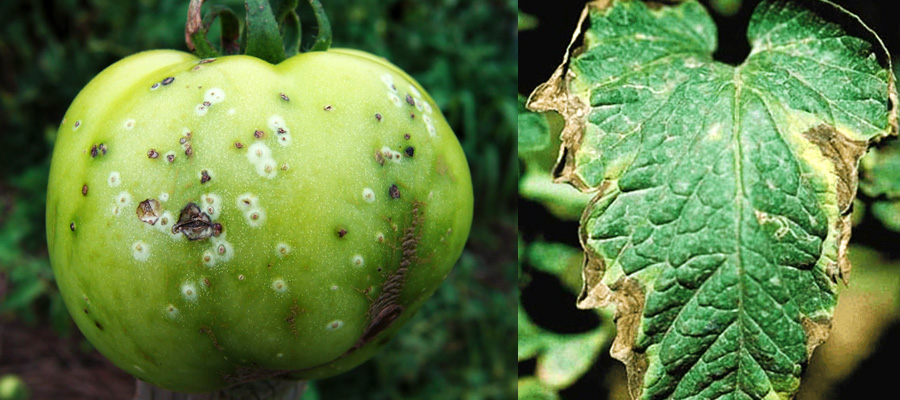Tomato Diseases are one of the main problems of people who cultivate or care for orchards. That is why we invite you to read this article in which the different pests and diseases that attack tomato crops are presented, their prevention and how to exterminate these evils in an ecological way and with the use of chemical products.

Tomato Diseases
Tomato diseases are one of the main concerns of horticulturists. That is why the need to recognize in time what type of agent attacks the plant and thus be able to act in time for the benefit of the plants. In many cases, the use of fertilizers is the most appropriate, but this brings with it collateral effects, since the excess of chemicals, apart from creating resistance, forcing the use of broader-spectrum pesticides, the fruit becomes contaminated and is then consumed by humans, bringing consequences long-term health.
tomato pests
There are a number of tomato diseases and pests that attack it excessively, so it is necessary that the people in charge of cultivating or caring for orchards know it in detail and thus identify it correctly and thus be able to apply the necessary treatment for its disinfection. Among the pests that are commonly found in tomato crops are:
-
Red spider (Tetranychus urticae)
It is a kind of mite that grows and reproduces on the underside of the leaf. This pest feeds on plants that are grown in dry environments that can be very damaging to crops. This tiny and almost imperceptible pest is oval and can come in different colors: orange, yellow, brown, red, green and even almost black. When they are in the form of a larva they have 3 pairs of legs and when they become a nymph it increases to 4 pairs. In the case of females, they have two dark lateral spots on the back and the male is smaller with a pointed abdomen and longer legs. In terms of color, they tend to be paler.
Diagnosis:
To know if the plant is contaminated, it is necessary to visualize the following symptoms: a considerable number of eggs of these mites are observed on the underside of the leaves, as well as the nymphs and adults, causing discoloration or yellowish spots, which can lead to necrosis, considerably reducing its development and growth. Yellow dots appear on the upper surface of the leaf. You can also perceive a spider web that protects them from acaricides.
-
White fly (Trialeurodes vaporariorum and Bemisia tabaci)
It is a pest that feeds on the underside of the leaf, being one of the most common in tomato plants, causing great damage. It comprises 3 larval stages, in the last stage it becomes round and yellowish, that is when it is called a pupa, where it develops until it reaches white, red eyes, which is when they are considered adults. His body is yellowish. They tend to colonize the softer parts of the plant, weakening them.
Diagnosis:
The larvae are located on the underside of the older leaves, facilitating the appearance of the bold ones, which are a type of fungus that appears after the plant is attacked by this pest, which prevents its commercialization. This also causes the leaves to begin to discolor, turning yellowish and becoming necrotic to the point of falling off, as well as the abnormal ripening of the fruit.
-
Heliothis (Helicoverpa armigera)
This one in a genus of moth, also known as cabbage caterpillar. It goes through 6 larval stages. They are presented in a spherical shape with a bright yellowish color that changes to brown. When they reach adulthood they turn cream colored with a delicate brown band at the tips. In the case of females they appear brown with orange overtones and males a grayish green. Their eggs are deposited individually in the shoots or buds of the leaves and fruits.
Diagnosis:
The larvae cause holes in the fruits and near the stems, which makes them unlikely to ripen properly as they tend to fall off prematurely. These caterpillars damage most of the fruits and seeds, causing large holes, which is why they become a reprehensible pest by damaging large crops.
-
Miner (Liriomyza spp.)
This is a fly that tends to embed its wings in the youngest part of the plant, causing galleries by feeding on them. Its larva that is deposited inside by the female and is presented in a transparent oval shape, which later turns whitish until it reaches an ocher yellow, passing through a metamorphosis (pupa) to reach the last stage. The males are smaller than the females, they are not equipped with mechanisms to make the holes, so the females do the work so that the male can feed later.
Diagnosis:
There are bites made by the adult miners to insert the larvae, making large galleries preventing the maturation and desiccation of the crops. These galleries are visible through the upper part of the leaves, although they can also be seen on the underside, which later becomes necrotic, notably reducing the photosynthetic capacity and allowing the penetration of fungi and bacteria.
-
Aphid (Aphis gossypii and Myzus persicae)
This species of pest is not related to the flea, its name is associated with the fact that they suck the sap of the plant. They have a great reproductive capacity making it one of the most destructive pests in horticulture. The females are viviparous and their reproduction is asexual and can generate up to 100 offspring, so their proliferation can reach alarming levels. It can be presented in various colors from green, yellow, white or brown, provided with a long beak to be able to absorb the juice of the plant. They are located in the green part, branches, stems and tender shoots of the plant.
Diagnosis: When extracting the sap from the plant, it tends to curl or wrinkle. A kind of molasses is produced that can cover most of the plant and attracts ants that also damage the plant. The petiole is deformed and deforms the fruits. Also attracting the bold. This pest is capable of transmitting viruses such as cucumber mosaic. This pest proliferates especially in autumn and spring.
-
Trips (Frankliniella occidentalis)
Also known as spider mite, it is a tiny species. It develops in two stages and grows within plant tissues, fruits and flowers. They appear white or pale yellow and when they are adults they are golden. As adults they have two pairs of wings. The female tends to be slightly larger than the male. They have become a harmful pest for tomato plants, as they extract fluids from plant cells. Its development time is 20 days, which will be determined by the environmental temperature. The cuan can range between 20 and 30 degrees Celsius.
The higher the temperature, the faster the development. The eggs are embedded in the cuticle of the tissues, hatch quickly, becoming highly mobile larvae and begin their feeding process immediately.
Diagnosis:
The adults prefer the upper part of the leaves, while the nymphs look for the underside. The leaves begin to deform, to the point that the bud cannot open. Thanks to the saliva of the thrips, chlorotic spots (pale green) begin to appear on the leaves and on the whitish fruits. The excrement of this plague can necrotize the plant and the fruit.
-
Tomato moth (Tuta Absoluta)
This moth is also known as the tomato armyworm or miner, it is a lepidoptera or nocturnal butterfly that lays up to 260 eggs that go from white to yellow and later turn black when hatching approaches, they turn green with a black stripe in the head. The pupa occurs on the ground and when they become adults they turn grayish brown and have curved labial palps. Like thrips, they make large galleries in leaves, stems, and fruit.
Diagnosis:
They leave remains of excrement when they make the galleries, the larvae have moments in which they come out of the galleries. Stains appear on the leaf. The larvae only feed on green fruits, bringing as a consequence cryptogamic diseases, that is, the evolution of fungi or parasites, causing the fruit to rot, since the holes and the interior turn black.
Tomato Virus Diseases
These tomato diseases are mainly transmitted by aphids, thrips and whiteflies. Viruses end up exhausting the plant, which results in its unproductiveness. Mostly, the symptoms of viral diseases are very similar, which is why laboratory studies are recommended. Here we name some of the most common viruses in tomato plants.
-
Tomato black plague or tomato wilt virus (TSWV)
This is a virus also known as the suntan virus, it spreads more easily in dry climates and is very fast-spreading and highly resistant when attacked. It manifests itself on the leaf with bronze-colored necrotic lesions, although it begins with chlorotic rings that darken over time. A kind of light-colored abstract drawing appears on the fruit, which prevents it from having a homogeneous color during ripening. Its transmission is primarily through thrips and is carried out through the bite of the healthy plant and is transmitted from one plant to another.
-
Tomato Mosaic Virus (TMV)
The mosaic virus is among the main tomato diseases, which presents with discoloration and alteration of shape, as well as the appearance of chlorotic and dark green areas, the fruit is reduced in size, internal and external necrosis; in the case of leaves they tend to curl. Its intensity will be determined even by the incidence of sunlight on the plant, the temperature and the amount of nitrogen contained in the soil. Its spread is by contact of a diseased plant with a healthy one, the effects of the wind or through the growers. Its strain can be preserved for years and originates from contaminated seeds.
-
Tomato yellow curl virus, or spoon virus (TYLCV)
This virus is also known as the spoon virus, it paralyzes the growth of the plant and the reduction of the leaves, where the petiole is rolled up and the fruit does not reach maturity and the color tends to be pale. This virus is transmitted by whitefly. When the plant is severely affected, it does not generate fruit, but if it happens when the fruit is already formed, it is hardly affected.
-
Tomato ringspot virus (TRSV)
This virus has several forms and is one of the most insidious, it is easily spread from diseased to healthy plants through pollen and dagger nematodes, a kind of worm present in the soil. These spots can be very visible, yellowish until the reduction in the size of the tomato. This virus can be present in plants in an asymptomatic way, which makes its timely control difficult, which makes this virus incurable, which should be expected to disappear on its own.
-
Tomato ringspot virus (CMV)
In this case, the plants already present stunting, deformed leaves, that is, they present necrosis both in the stem and in the petiole and a notable reduction in the leaf blade, which can cause the death of the plant. As for the fruit, it presents yellow rings that remain even when the tomato is ripe.
-
Potato y virus (PVY)
It is a virus belonging to the Potyviridae family. It is considered the second in degree of importance of tomato diseases, characterized by presenting yellowish and necrotic spots on the leaflets and in the fruit there is evidence of an alteration in the homogeneity of the color.
Bacterial Diseases of Tomato
Taking into account that bacteria are prokaryotic organisms, that is, they do not have a nucleus that uses wounds and natural openings of the plant to penetrate and lodge causing tomato diseases. For this reason, it is necessary to learn to identify them in order to attack quickly, as they have an extended destructive capacity, causing necrosis and subsequent rotting, which requires appropriate control. The most common diseases are:
-
bacterial stains (Xanthomonas campestris pv. vesicatoria):
It is a foliar disease that spreads in hot and rainy times, notably reducing the quality of the fruit. Its symptoms are similar to bacterial freckle. It appears as a dark, fibrous spot that grows to a diameter of 8mm, especially on the leaf margin. When the condition becomes severe, the plant ends up defoliating (premature leaf fall). It can contaminate the fruit and its seed and it favors warm temperatures, from 20 to 30 degrees Celsius. It spreads through infected seeds, appearing a week after infection.
-
Bacterial Freckle (Pseudomonas syringae p.v. tomato):
This bacterium can attack any part of the plant, but it tends to settle on the foliage, then on the stem and later on the fruit. They appear as moist spots that later become necrotic, surrounded by a yellow halo that can join together to form larger spots. Sunken brown cones tend to appear in the fruit, which is very destructive to the tomato. It has great resistance, which spreads rapidly in humid to cold climates. Its symptoms appear after a week of infection, the dissemination of this bacterium can also be done through the transplant.
-
Bacterial Cancer (Clavibacter michiganensis subsp. michiganensis)
This is one of the tomato diseases, also known as vascular necrosis, it is highly contagious and destructive. It appears as a burn on the margins of the lamina and necrosis in the foliage until the death of the plant. In the fruit it appears as a crusty spot with a white halo, as the disease progresses it attacks the stem. Its contagion can be given by the seed or seedling (transplant), once the soil is infected, the pathogen enters the plant through wounds that could be caused by the winds in the root or stem invading it. The bacterium spreads in humid environments and favors sprinkler irrigation.
-
Potato mildew or late blight (Phytophthora infestans)
It is a kind of parasite that infects tomato plants, it is a pathogen that produces the darkening of the leaves that at first becomes oily and later ends up necrotizing the leaf. It appears mostly on the underside in the form of white powder, on the stem it appears in the form of brown spots as on the fruit, in the latter it worsens at the top causing the fruit to rot as well as a bad smell.
-
Oidium (tauric leveillula)
The powdery mildew or also known as blanquilla. This is one of the tomato diseases that appears as white spots on the underside of the leaf that tend to become necrotic in the center. This is caused by a fungus with the same name, it is transmitted from the old to the youngest leaves, which It hinders the evolution of the plant, causing defoliation and, as an alternative effect, the burning of the fruits that are exposed to the sun's rays.
-
Alternariosis or early blight (Alternaria Solani)
This phytopathogenic bacterial disease that manifests itself in plants located in humid areas with high temperatures. In this case the fruit tends to rot, it can also attack the leaves and the stem. Yellowish spots appear on the leaves, then turn brown and the leaves fall off, the bacteria go upwards, the lesions turn into a chlorotic halo. For its part, the stem is presented with an elongated blackening. Destruction of the leaf tissue can be observed in the fruit, notably affecting the quality of the tomato.
-
Gray rot or mold (Botrytis cinerea)
In the case of this rapidly spreading bacterium, it occurs in large numbers of asexual spores that rot and deform tomatoes. It tends to soften the fruit where gray hairs grow, which is the manifestation of the fungus. That softening is accompanied by a rotting and watery form. It occurs in conditions of high humidity. Which can be stopped by exposing the fruit directly to the sun or high temperatures, hence it is considered a weak parasite. For this reason, a well-ventilated environment and constant pruning and subsequent disinfection with fungicide are recommended.
-
Cladosporiosis (fulvia fulva)
This bacterium is housed specifically in the leaves of the tomato plant, in which yellowish spots are observed on the underside and on the upper side it turns grayish. They range from the oldest leaves to the youngest, as the fungus advances, the leaves turn yellow and end up falling off. In the case of the fruit, parts turn pale yellow, which then ends up rotting. It is important to know that this fungus can survive on dry leaves found on the ground. That is why it is recommended to eliminate weeds, treat the soil where the new seeds will be grown.
-
Fusarium wilt (Fusarium oxysporum)
This fungus belongs to tomato diseases, its main form is wilting that ends up killing the plant. It enters through the root. In order to discover this fungus, it is necessary to do it through laboratory tests because its manifestation is very similar to other fungi. In the case of invading the stem, it manages to necrotize the vessels, preventing the plant from feeding. One of the most effective ways to avoid this disease is crop rotation and using nitrous nitrogen instead of ammonia.
-
Anthracnose (Colletotrichum spp.)
In the case of this fungus, it is very common to find it in hot and humid areas, characterized by black lesions, surrounded by a yellowish color that are manifested preferably around the nerves of the leaf. In the case of fruits, this develops in the tomato when it is in the ripening period and its symptoms manifest when the tomato is already ripe. Dark and watery spots appear, causing subsidence and subsequent rotting.
As for the root, it also turns dark in color until it rots. To avoid the spread of this disease, it is recommended to clean the soil well, water and fertilize, as well as remove weeds or weeds.
-
Rust (Puccinia graminis)
This is an invasive species of fungus that attacks most garden plants, especially tomato plants. It appears mostly in rainy weather and hot weather. The leaves begin to present tiny pustules on their undersides that turn red, orange or yellow that gradually turn dark. In the upper part of the leaf, more discoloration is observed. The affected leaves end up dying and fall, when the infestation is severe, almost total defoliation occurs, generating the death of the plant, it can even appear in the fruit.
How to Avoid Tomato Diseases
Tomato diseases can cause irreversible damage affecting not only the fruits but also the leaves, stems and petioles. This is caused by the interaction of pathogens and the environment. To prevent the spread of different diseases, it is recommended to follow the following tips:
- Use healthy seeds, to ensure good condition, soak in hot water for a few minutes, then add 1% sodium hypochlorite for a maximum of 40 minutes. You can also use 10% hydrochloric acid for 10 hours.
- Avoid planting near abandoned fields.
- The planting should be watered only when required, but in hot weather try to use irrigation methods that keep the temperature low.
- Make sprays with a combination of copper, mancozeb (selective and high-spectrum fungicide that prevents the appearance of fungi), zinc and some recommended antibiotics.
- Avoid working when the plants are wet, this will prevent the spread of diseases.
- Get rid of any plants that show signs of disease.
- Regularly use Actigard, which is a powerful plant protector against diseases such as mold, bacteriosis, which is absorbed by the leaves and stems, activating the plant to generate good fruit. It is recommended to use it every 15 days and make a first application immediately after transplanting. This product is best used in the late afternoon, before or after expected rain showers.
- It is recommended to spray with skimmed milk powder to prevent plants from being burned by ultraviolet rays.
Ecological treatments
One of the best allies for tomato planting in small orchards is the infusion of garlic, which mainly effectively combats aphids, red spiders and rot. It is recommended to spray five days in a row before sunset or first thing in the morning.
The nettle or horsetail slurry treatment is very effective for treating fungi, mites and aphids, as well as other tomato diseases, since its fermentation creates bacteria that help fix nitrogen in the soil, turning it into an organic fertilizer. It is not recommended to prepare the fungicide in metal containers due to the rust that can be generated, which damages the content. For its preparation it is suggested to use rainwater, let it ferment for 20 days, then reduce for each liter of slurry add 15 liters of water.
General Tomato Plant Care
Tomato plants require special care due to the amount of pests, fungi and bacteria that they can acquire, that is why it is suggested to rotate the crops, that is, if vegetables were grown, use that land for the tomato plants, in this way the monocultures and the proliferation of certain pests. It is also necessary to take care of the land with enough fertilizer and humidity (without reaching flooding), required to strengthen fertility, as well as the use of organic treatments so that they do not affect the development of the plant. Irrigation is recommended to be done through the drip technique to control the amount of water it receives.
It is advisable to remove the affected parts of the plant, and in some cases it must be completely removed. To work in orchards or plantations, work tools must be disinfected and thus prevent the spread of some diseases. It is important to take into account that it is not recommended to plant near marigolds because they are attractive to aphids, unlike basil, which is a repellent par excellence not only of this parasite but also of red spiders, mites and worms.
Also, to prevent the plants from being invaded by ants, you can make steps of coffee and thus cut their way, you can also use nettle macerate and keep the plant free of diseased leaves. Finally, it is necessary to know that the excessive use of nitrogen or fertilizers can end up attracting certain pests that will destroy the plants.
Interesting Tomato Facts
Did you know that the first tomatoes in Europe were not red but yellow, that's why they baptized it as the golden apple and considered for a long time as a toxic fruit. There was a tomato plant with more fruits in the world that weighed 522 kilos, with 32000 tomatoes.
Likewise, the largest tomato recorded in the world weighed 3,51 kilograms and the tallest plant reached 19,8 meters. This fruit is composed of 95% water in its more than ten thousand varieties. The tomato not only has culinary purposes, it also has its medicinal properties, since its consumption in the case of men helps maintain a healthy functioning of the prostate.
I invite you to watch this video that will instruct you on how to treat the tomato plant. Press play and learn much more!
If you want to know a little more about plants, follow these links:






